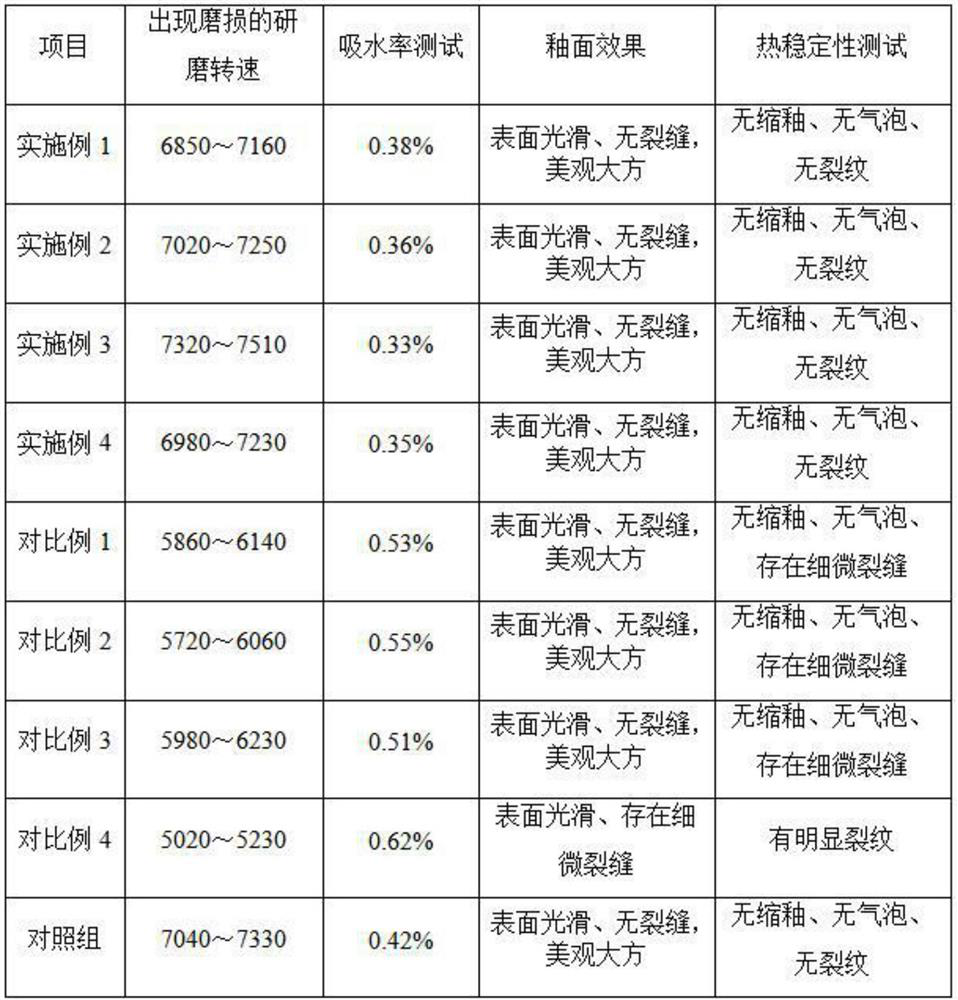A kind of ceramic handicraft and preparation method thereof
A technology for ceramic handicrafts and lithium porcelain stone, which is applied in the field of ceramic products, can solve the problems of medium and low temperature ceramic color stagnation, low firing temperature and high water absorption, and achieve uniform and dense texture, lower firing temperature and low water absorption. Effect
- Summary
- Abstract
- Description
- Claims
- Application Information
AI Technical Summary
Problems solved by technology
Method used
Image
Examples
Embodiment 1
[0036] A preparation of ceramic handicrafts, comprising the following steps:
[0037] S1. Green body preparation:
[0038] S11. Select the corresponding raw materials according to the green body formula, mix potassium feldspar, quartz, kaolin, wollastonite, lithium china stone, bentonite, talc, and alumina, and perform wet ball milling to pass through a 350-400 mesh sieve, and the sieve balance 0.2-0.4wt%;
[0039] S12. Then continue to add polymethyl methacrylate, calcium silicate, konjac glucomannan and lanthanum oxide, stir evenly to obtain a green body slurry, and the flow rate of the green body slurry is about 40 seconds;
[0040] S13. Shape the green body slurry to obtain a rough green body. After the appearance of the rough green body is trimmed, it is immersed in a sodium bicarbonate solution with a pH of about 8.0, and the temperature is raised to 60° C. for 25 minutes, and then taken out and air-dried to obtain a green body.
[0041] S2. Glazing: select the corresp...
Embodiment 2
[0047] A preparation of ceramic handicrafts, comprising the following steps:
[0048] S1. Green body preparation:
[0049] S11. Select the corresponding raw materials according to the green body formula, mix potassium feldspar, quartz, kaolin, wollastonite, lithium china stone, bentonite, talc, and alumina, and perform wet ball milling to pass through a 350-400 mesh sieve, and the sieve balance 0.4-0.6wt%;
[0050] S12. Then continue to add polymethyl methacrylate, calcium silicate, konjac glucomannan, and lanthanum oxide, stir evenly to obtain a green body slurry, and the flow rate of the green body slurry is about 45 seconds;
[0051] S13. Shape the green body slurry to obtain a rough green body. After the appearance of the rough green body is trimmed, it is immersed in a sodium carbonate solution with a pH of 8.5, and the temperature is raised to 65° C. for 20 minutes, and then taken out and air-dried to obtain a green body.
[0052] S2. Glazing: select the corresponding ...
Embodiment 3
[0058] A preparation of ceramic handicrafts, comprising the following steps:
[0059] S1. Green body preparation:
[0060] S11. Select the corresponding raw materials according to the green body formula, mix potassium feldspar, quartz, kaolin, wollastonite, lithium china stone, bentonite, talc, and alumina, and perform wet ball milling to pass through a 350-400 mesh sieve, and the sieve balance 0.2-0.3wt%;
[0061] S12. Then continue to add polymethyl methacrylate, calcium silicate, konjac glucomannan and lanthanum oxide, stir evenly to obtain green body slurry, and the flow rate of green body slurry is about 42 seconds;
[0062] S13. Shape the green body slurry to obtain a rough green body. After the appearance of the rough green body is trimmed, it is immersed in a sodium hydrogen phosphate solution with a pH of 8.2, and the temperature is raised to 62° C. for 22 minutes, and then taken out and air-dried to obtain a green body.
[0063] S2. Glazing: select the correspondin...
PUM
| Property | Measurement | Unit |
|---|---|---|
| particle diameter | aaaaa | aaaaa |
| particle diameter | aaaaa | aaaaa |
| particle diameter | aaaaa | aaaaa |
Abstract
Description
Claims
Application Information
 Login to View More
Login to View More - R&D
- Intellectual Property
- Life Sciences
- Materials
- Tech Scout
- Unparalleled Data Quality
- Higher Quality Content
- 60% Fewer Hallucinations
Browse by: Latest US Patents, China's latest patents, Technical Efficacy Thesaurus, Application Domain, Technology Topic, Popular Technical Reports.
© 2025 PatSnap. All rights reserved.Legal|Privacy policy|Modern Slavery Act Transparency Statement|Sitemap|About US| Contact US: help@patsnap.com

